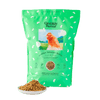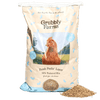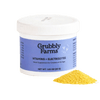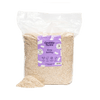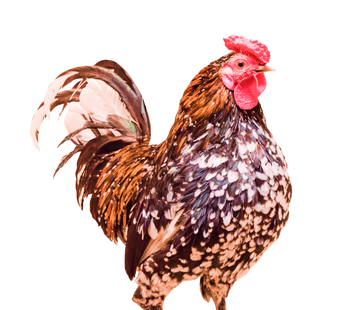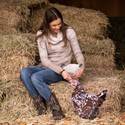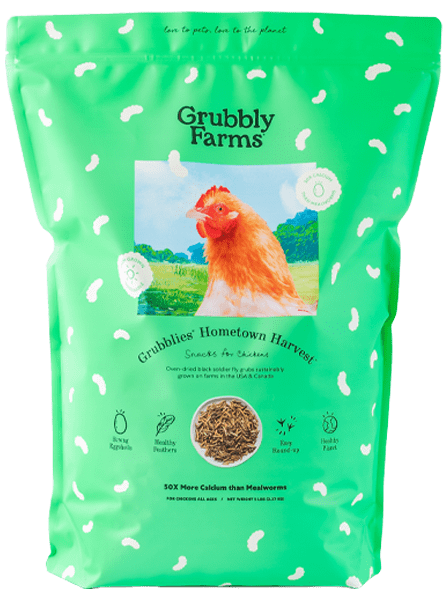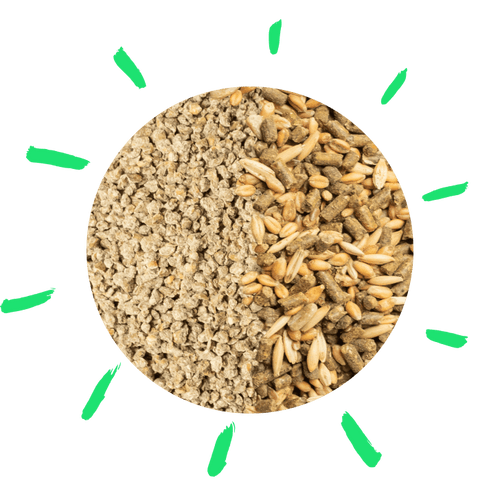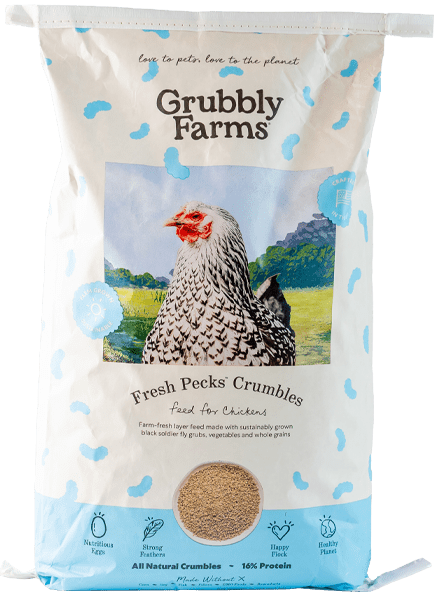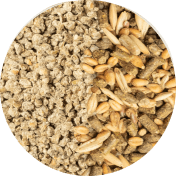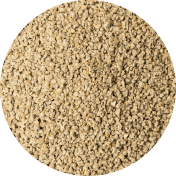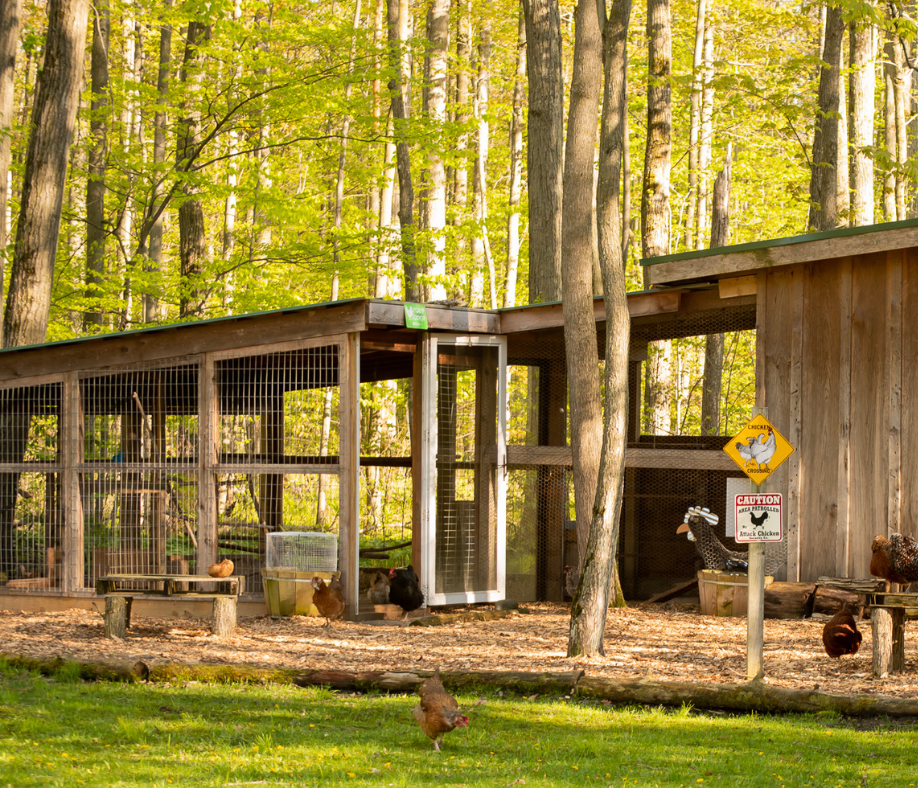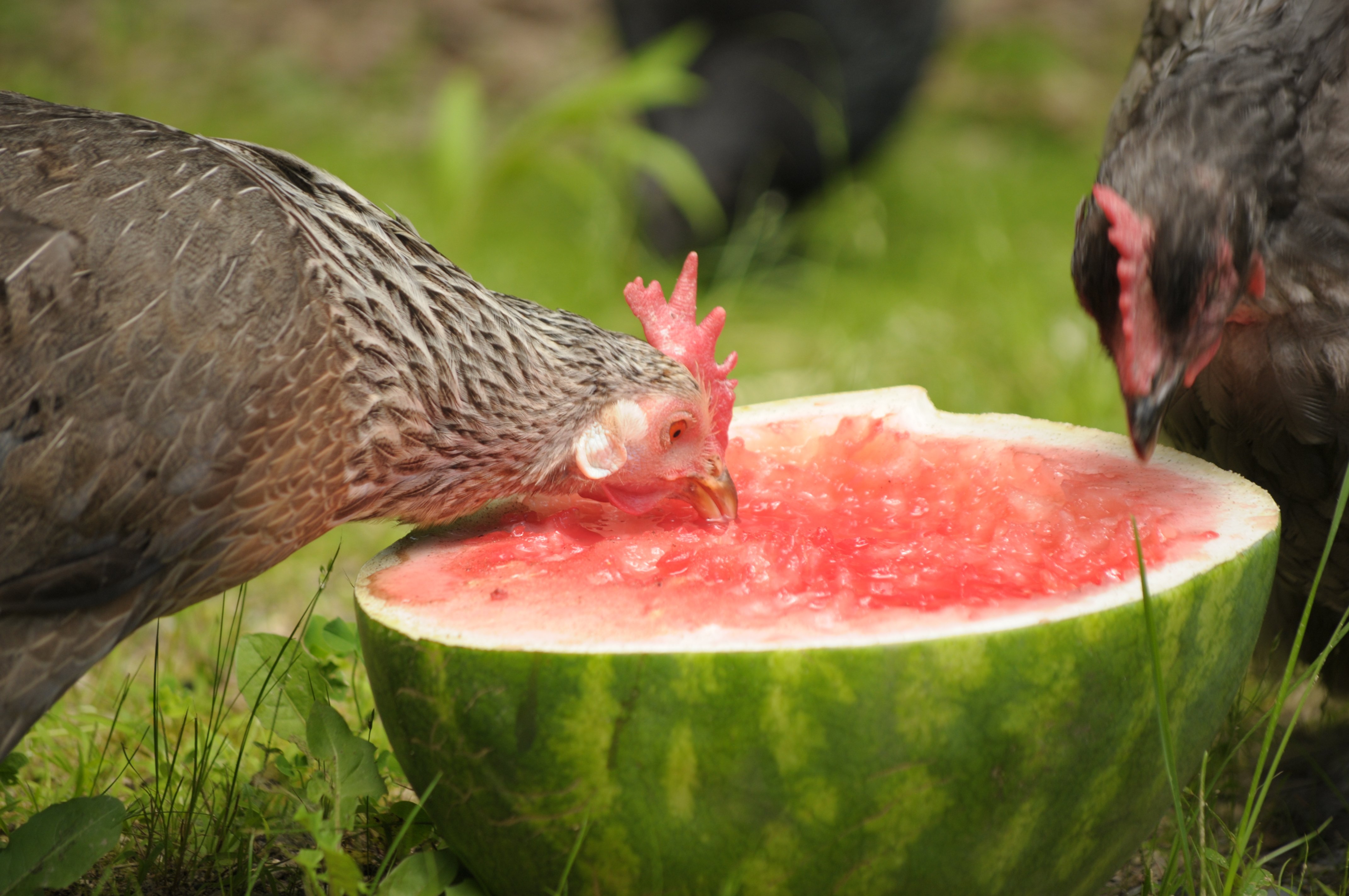With backyard chicken keeping on the rise, there is a lot of information out there about how to raise chickens! Skip all the muck, muddle, and confusion and go straight to the essentials with our 7 core aspects of raising a backyard flock. Raising your own chickens does take time, responsibility, and commitment, but you’ll be rewarded with a renewed sense of sustainability and confidence as you care for and maintain your own flock!

#1. Picking the Perfect Breed
The first step on your chicken journey is figuring out what chicken breeds will best suit your needs and situation. Most chicken breeds can be categorized into one of four categories:
- Production breeds developed for egg production
- Meat breeds developed for the purpose of providing a good quantity of meat
- Dual-purpose breeds that can be used for either egg production or for providing meat
- Fancy breeds, mainly for look and appearance, although some are decent egg layers
Decide what your reasons are for raising a backyard flock, then decide which category you should select breeds from based on your needs.
You should also consider if you want to go with heritage chicken breeds or hybrid chicken breeds. Heritage chicken breeds have been genetically preserved over the years and have a breed history. Hybrid chicken breeds have been developed by the production industry for specific purposes. They are typically a combination of breeds and usually cannot be bred true. Meaning, two hybrid chickens cannot be bred together to create the same hybrid breed. Well-bred heritage chicken breeds are typically known for having a longer life span, being hardier, having better temperaments, and being a more sustainable breed option. Hybrid chicken breeds are better at meeting high production expectations. Some strains can have docile, friendly temperaments that are a nice addition to the backyard flock.
Many backyard chicken raisers choose to go with dual-purpose heritage breeds for their first flock. These breeds are often easy to acquire, have friendly temperaments, are hardy, and still produce a good quantity of eggs or meat. Some popular beginner chicken breeds include the Orpington, Australorp, New Hampshire Red, Rhode Island Red, Plymouth Rock, Brahma, and Cochin.
When choosing the perfect breeds for your backyard flock, consider these qualities:
- Purpose: Eggs, meat, or both
- Temperament: Docile and friendly or flighty and independent
- Environmental conditions: Cold hardy breeds, heat tolerant breeds, or both
- Broodiness: If you think you might want to have a mama hen raise chicks in the future, consider getting a breed that may have some broody individuals

#2. Raising Chicks
Once you’ve decided what breeds are best for your first flock, your next task will likely be raising baby chicks! Chicks are cute, fun, and exciting, but they are also a lot of work and responsibility. We'll cover some high level basics on chick raising, but for more details check out our in-depth guide on how to raise chicks.
First you will need a brooder. A brooder should be a safe and protected home for your new chicks that provides them with food, water, and heat. The brooder should also be lined with an easy-to-clean litter that is absorbent and will prevent any bacteria from building up between cleanings. The food and water should be contained in a chick-size feeder and a chick-size waterer. The feeder should keep the food clean and dry as well as have enough space for all the chicks to eat from the feeder at once. The waterer should keep the water clean and contained and should not present a drowning hazard or any way that a chick could get stuck and become chilled. For a heat source, you can go with a generic heat lamp or a radiant heater. If you go with a heat lamp, you need to have a sturdy system to support the lamp as well as a way to raise or lower the lamp safely. A much safer and more natural option is to invest in a radiant heater. The radiant heater more closely mimics a mother hen, does not present a fire hazard, and allows the chicks to control their heat needs on their own. Learn how to properly set up the brooder for your chicks in our brooder guide!
The chicks will need supplemental heat in a brooder for at least the first 4-5 weeks of their life. After that, they may need to be moved to a larger pen as they grow. The young chickens can be moved outside after they have grown in all of their juvenile feathers and only if the outside temperatures are reasonable. Ideally, the outdoor temperatures should not be getting below 50-55°F if you permanently move your young chickens to an outdoor coop. Any enclosure or housing that you keep your young birds contained in should be completely predator proof. Sturdy building materials such as wood, hardwire cloth, and secure latches are important for keeping your new flock safe from predators.
If you got chickens for the purpose of egg laying, then you can expect the young pullets (female chickens under 1 year old) to start laying around 20-24 weeks of age. The heritage breeds will often take longer to mature to production age than hybrid laying breeds. The first eggs a pullet lays are often small and are sometimes called ‘fairy eggs’. Don’t worry, the eggs will increase to the normal size for the breed as the pullet’s reproduction system gets into the swing of things!

#3. Housing
Those little cute fluff balls will quickly outgrow their brooder, so you'll need safe housing ready for their long term care. If your brooder is large enough, you can keep the young chickens in the brooder until they are old enough (and fully feathered) to move into an outdoor coop. Your flock’s coop should be a safe haven for them that provides protection from both predators and the weather. There’s countless ways to setup and design and ideal coop, as long as it has all the right elements for your flock. Use this checklist to create your ideal coop:
- Litter: Three popular options are hemp, large flake wood shavings, sand, or straw (not hay). Any of these absorbent options should be laid on a solid flooring within the coop.
- Feeder: You can choose to do a hanging feeder, a homemade feeder, or a free-standing feeder.
- Waterer: Again, you can choose a hanging water system, a nipple water system, or a free-standing waterer.
- Nesting boxes: At least one for every 5 hens.
- Perches: There are numerous styles of perches, but for any of them, always allow approximately 10 inches of perch space per bird.
- Predator protection: Seal off any holes no matter how small they are, secure hardwire cloth over window openings or ventilation openings, use predator proof doors and latches.
- Weather protection: The coop should be covered with a weather-proof roof and should be sturdy enough to withstand winds and other environmental conditions.
The coop should also be able to accommodate the number of birds you have, as well as allow for "chicken math" to happen in the future. Always build (or buy) for a bigger flock than what you plan on raising! Or at least choose a design that’s easy to expand. On average, allow about 2-3 square feet of space per bird in the coop.
The coop should have a weather and predator proof enclosure attached to it, with a chicken door that allows your chickens access from the coop to the enclosure. The enclosure should be secured with predator proof poultry fencing (like hardwire cloth) and covered with a weather-proof roof. It should have a litter that is well-draining to prevent puddles from building up in the enclosure. You may also need to install a ramp from the enclosure floor to the chicken door so that the chickens can easily get to their coop. For the enclosure, allow at least 6-8 square feet of space per chicken.
Coops can be as fancy or as frugal as you want (without compromising on the essentials mentioned above). However, there are some nice amenities you may consider adding to your coop design:
- Electricity: Helpful for adding light fixtures to the coop or for installing heated water systems.
- Storage space: Keep all your cleaning supplies, feed, and extra chicken keeping supplies right out at the coop
- Automatic Chicken Door: Never forget to open or close the chicken door for your flock to keep them safe from predators!
- NiteGuard: Deter predators by mounting these little warning systems around your coop and enclosure.
- Curtains and Drapes: Adds a homey feel to the coop, plus the hens like the privacy of nesting box curtains.
- Droppings Boards or Slings: these handy features catch the nightly droppings below the roosts and make for easy poop removal in the morning.
#4. Food & Water

Feeding chickens is pretty simple when you stick to nature’s basics. For chicks, you should start them off on a complete chick starter feed, which contains all the nutrients and proper protein for healthy growth and development. The important factor in chick starter feed is the protein level. A quality chick starter feed should contain between 18-24% protein. A high protein content is essential for proper growth and development. Chick starter feed is also made into smaller particles to make it easier for the chicks to eat and digest.
Grubbly Little Pecks starter grower chick feed is a great option as it mimics what your chicks would eat in the wild. It’s made with black soldier fly grub protein, plants, vitamins, minerals, and probiotics to ensure your chicks have everything they need to grow up strong and healthy.
Since Little Pecks is both a starter feed and grower feed, you don’t have to worry about changing your chick’s diet as they grow. If you feed your chicks just a starter feed, then you will want to switch to a grower feed according to the manufacturer's instructions on the feed bag.
Once your young chickens reach about 18-20 weeks of age, you will want to switch them to a layer feed. The layer feed contains all the nutrition they need to support them as they enter reproduction age and start producing eggs on a daily basis. Layer feed is different from chick starter feed in the fact that it is lower in protein and contains more calcium. While laying hens still need a high amount of protein, the percentage can back off to around 16-18% protein since the hens do not need protein for growth and development. The extra calcium in layer feed is essential for helping the hens produce strong, sturdy eggshells. Grubbly Fresh Pecks is an excellent option since it’s a sustainable poultry feed that contains only natural ingredients. Unlike other feeds, you won’t find any fishmeal, soy, or corn. All of Grubbly’s feeds are made with grubs and plants, so you can keep your chickens on a healthy, natural diet.
With all this talk about hens, you may be wondering about roosters. They don’t lay eggs, so should they be fed a layer feed? Roosters do not need the extra calcium that is in layer feed. However, most backyard chicken keepers find it just as easy to feed their whole flock, including roosters, layer feed rather than trying to make sure each sex gets their own feed. Feeding a whole grain layer feed allows the roosters to avoid consuming too much calcium while still being able to consume the ingredients they need for proper nutrition.
Along with the layer feed, you should also supply some essential supplements. There are three main dietary supplements that your flock will need: calcium, protein, and grit.
- Calcium: Essential for strong eggshells. Supplemental calcium commonly comes in the form of crushed oyster shells that you provide in a free-choice supplement dispenser for your hens to consume as they wish. The supplemental calcium can help prevent any calcium deficiencies in your flock’s diet which will ensure the hens can stay healthy and productive.
- Protein: Supplemental protein is needed during the fall months, when your chickens do their annual fall molt. The molt is when a chicken gradually loses all its feather and regrows them, which requires lots of protein. Supplemental protein may also be needed during the winter months if your region experiences extreme temperatures. Cold weather requires extra protein for helping chickens stay warm and healthy. Supplemental protein can be provided in the form of Grubblies, sunflower seeds, whole oats, meat scraps, or sprouted legumes, to name a few! It can be provided as a daily snack for your flock to help them meet their increased protein needs!
- Grit: If your chickens don’t have access to dirt or coarse sand, you will need to have a free-choice layer grit supplement available too. Grit is essential for the proper break down of foods in the chicken’s crop. There are two kinds of grit, layer grit and chick grit. Each grit is formulated for the appropriate age. Layer grit will contain larger particles and be coarser than chick grit. If your flock free-ranges or you use sand as the coop litter, supplemental grit will not be needed.
Your flock should have access to fresh, clean drinking water at all times. Clean and refresh the water at least once a day to prevent algae or bacteria from building up in the waterer. Any feeder or waterer system you use should keep the contents clean and free from debris. The feeder should also keep the food dry since wet feed can easily mold and cause disease. Both the feeder and the waterer should hold the appropriate amount of food for the size flock that you raise. Ideally, both should contain enough food/water to last your flock two days. The feeder should be located in a place where rodents and wild birds cannot access it. Your flock should have free-choice access to food and water all day long. Chickens naturally snack on their food throughout the day, which provides their metabolism with energy to keep them active all day long.
#5. Daily Care & Cleaning
Your flock will require daily care, ideally at least twice a day. Of course, since chickens are so fun and entertaining to watch, you will find yourself spending more time out at the coop than you ever imagined! But aside from entertainment, there is also work to be done. Here are some chores that should be done a daily basis:
- Clean up droppings
- Fill the feeder
- Clean and refresh the water
- Collect eggs
- Open and close the chicken door in the morning and evening
When and how you decide to get these chores done is up to you and your schedule! There will also be chores that don’t need to be done on a daily basis but they still need weekly or monthly attention. Some weekly chores may include cleaning up droppings in the enclosure or getting more chicken feed or supplements. Monthly chores may include cleaning out the coop litter and refreshing the nesting box litter. If you use large flake wood shavings as the litter in the coop, they will need to be cleaned out about every 3-4 months. A chore that should be done at least once a year is a thorough cleaning of the chicken coop. Chickens naturally make a mess and create ‘chicken dust’. A yearly cleaning of the coop will help prevent disease causing organisms from taking up permanent residence as well as control factors that can cause respiratory or lung issues.
If you live in regionally cold or regionally warm climates, then you may have some additional chores to do depending on the season. For areas that experience severe winters, winterizing the chicken coop is a must! For regions that experience hot summers, you’ll need to take measures to prevent heat stress.
#6. Troubleshooting
While we all wish to raise a happy and healthy flock, it’s likely that one or more of your chickens will experience health issues. Since your flock will spend most of their time outdoors, there are numerous environmental factors that can take a toll on the health of your flock. Not to mention factors such as genetics, flock dynamics, and stress. While the list of poultry ailments could fill a book, we will just touch on a few basics for monitoring and controlling the health of your flock.
First, you must know the signs and symptoms of a sick chicken. Chickens are prey animals, so they instinctually hide their weaknesses as best they can for as long as they can. Learning to recognize even the most basic signs of disease can be a huge help in monitoring the health of each flock member. Here are some basic signs that a sick chicken will exhibit:
- Lethargy- huddled with ruffled feather, not participating in normal behaviors and activities
- Diarrhea- especially poops that are runny, whiteish, contain blood, are mostly bile or contain worms
- Shriveled comb and wattles- can also be pale in color or discolored
- Coughing, sneezing, wheezing, or rattling
- Discharge from the eyes, nostrils, or mouth
- Thinness- feel along the breastbone for adequate meat/muscle
- Poop stuck to the vent feathers- often accompanied by diarrhea
- Stop in egg production
Unfortunately, many chicken diseases and ailments have overlapping signs and symptoms. This can make it very hard to make an accurate diagnosis. However, there are some fairly basic ailments that you should be aware of as you venture into raising a healthy flock:
- Bumblefoot: Appears as a black dot on the foot pad, may be accompanied by limping
- Crop issues: Sour smelling breath indicates sour crop, an enlarged and hard crop in the morning could mean impacted crop
- Respiratory Issues: Characterized by coughing, sneezing, wheezing, and sometimes discharge
- Internal parasites: Can cause diarrhea and weight loss, you may even see worms in the droppings
- External parasites: Look for tiny bugs crawling around the vent as well as parasite egg deposits at the base of the feathers
It is a good idea to do a monthly health check to stay on top of your flock’s health. Once a month, handle every member of the flock and examine them for signs of ailments and external parasites.
Your daily chores are an integral part of your flock’s health. Proper coop cleaning, a proper diet, and access to clean drinking water will set your flock up for success. When sickness or disease does strike, quarantine the ailing bird while you try and identify the issue. If you can determine an appropriate treatment, care for the bird until it returns to good health and can be re-integrated back into the flock.
#7. Treats, Supplements, & Snacks

When you’re done playing Chicken Doctor, treating your flock to healthy snacks can be a great way to promote health and bond with your birds. As with humans, too much of a good thing can make them sick, so always treat in moderation.
So what would a chicken consider a “treat”? Chickens are omnivores and can eat a wide range of foods, including items that may not be as palatable to us. Feeding your flock your leftover table scraps is one sustainable way to spoil them. Healthy table scraps that you can give your flock on a regular basis include fruit and vegetable scraps and cooked meat scraps. Table scraps that should be limited or fed in moderation include whole grain bread and whole grain cereals or pastas.
Along with table scraps, you can also feed your flock nutritious snacks. These are foods that supplement your flock’s diet but are not essential to their daily well-being. Grubblies are one of the healthiest snacks you can feed your flock. These dried black soldier fly grubs mimic what chickens would naturally forage for in the wild. While many chicken owners feed their chickens mealworms as a supplement, black soldier fly grubs have 50x more calcium to support egg production. They’re also packed with protein to help your birds grow healthy and strong feathers. Once your chickens are familiar with Grubblies, you’ll find all you have to do is shake the bag- they’ll come running! It’s a great trick to round them up quickly back into their coop after free ranging. Other nutritious snacks that can be fed (in moderation) include whole grains such as oats, seeds (like sunflower seeds), and legumes (like lentils or peas).
Lastly, you can also venture into the wonderful world of natural supplements for chickens. Natural supplements are used to prevent certain ailments and disease, boost the immune system, or address certain issues within the flock. Natural supplements should be used with a knowledge of what the specific supplements do and how they can be provided to your flock. Some common natural supplements include apple cider vinegar, garlic, various herbs and spices, probiotics, sea kelp, and brewer’s yeast. Some good beginner supplements to start off with include adding crushed garlic to your flock’s water once a week and supplying them free-choice herbs that they can consume as they wish.
Feathered Fun!

Armed with these 7 aspects of raising backyard chickens, you should be all set to start your own flock! From choosing the perfect breeds to building a secure coop to daily chicken care chores, raising chickens is an adventure that is well worth the journey. Knowing the basic needs of your flock and how to meet those needs will set you up to successfully raise and care for a healthy, happy flock of hens!
